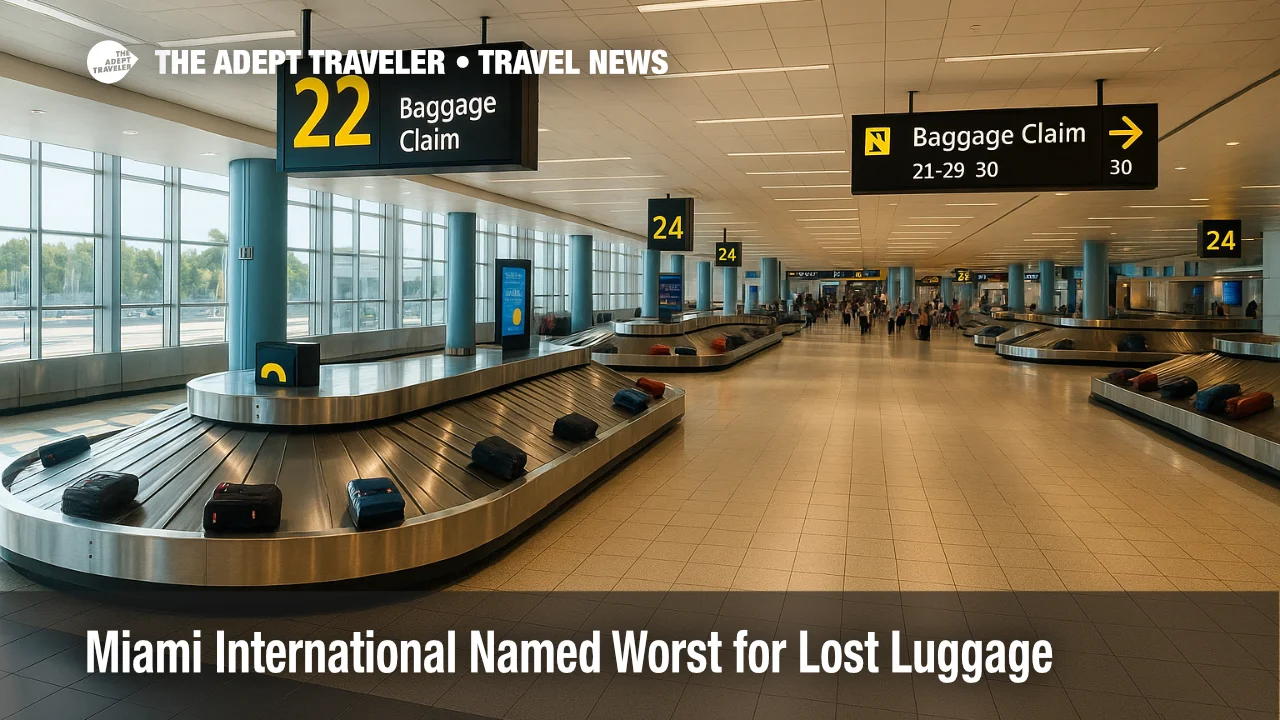Miami International named worst for lost luggage

A new analysis highlighted by Travel + Leisure on August 11 names Miami International Airport as the world's worst hub for lost luggage, placing several U.S. airports near the top of the ranking. The study, conducted by packaging firm Arka, blends passenger volume with search interest for airport lost-and-found to identify where bags most often go missing. Chicago O'Hare, Denver, and Dallas Fort Worth also appear in the top 10, alongside Singapore Changi. The finding arrives as global mishandled baggage rates fall, but absolute volumes remain high. Context and methodology matter for travelers interpreting these airport rankings.
Key Points
- Why it matters: Miami International Airport (MIA) topped a new ranking for lost luggage.
- Travel impact: Results vary by method, so route decisions should weigh multiple baggage metrics.
- What's next: Industry tech upgrades continue to lower mishandled-bag rates worldwide.
- Arka's analysis also placed O'Hare, Denver, and DFW in the top 10, with Changi at No. 3.
- Orlando ranked worst in a separate 2025 TSA-based study, underscoring method differences.
Snapshot, lost luggage context
Arka's model blends passenger counts with searches for airport "lost and found" services, normalized per million passengers, then overlays regional mishandled-bag rates. Travel + Leisure reports MIA sees roughly 52 million passengers a year and about 1,000 daily flights, with an estimated 5.5 lost bags per 1,000 passengers in the study. Chicago O'Hare International Airport (ORD) ranks No. 2, Denver International Airport (DEN) No. 4, Dallas Fort Worth International Airport (DFW) No. 9, and Singapore Changi Airport (SIN) No. 3. Results are directional, not definitive, because search behavior can reflect traveler demographics and trip purpose.
Background
Miami International Airport handled a record 52.3 million passengers in 2023, cementing its role as a gateway to Latin America and the Caribbean and helping explain its heavy baggage throughput. Mid-2023 county data already had the airport pacing toward 52 million travelers. At the global level, SITA's 2025 Baggage IT Insights reports 33.4 million mishandled bags in 2024, a rate of 6.3 per 1,000 passengers, down from 6.9 the year prior, as more airports deploy tracking and automation. That broad trend is positive even as large hubs continue to face peak-day strain. For local context, Miami is investing in long-term terminal and systems upgrades. Miami-Dade mid-year release.
Latest Developments, lost luggage rankings
Arka's analysis puts MIA at No. 1
Travel + Leisure's report on Arka's findings lists Miami International Airport (MIA) as the worst for lost luggage, with O'Hare, Denver, and DFW also in the global top 10, and Singapore Changi at No. 3. The methodology combines passenger volume and normalized searches for lost-and-found, supplemented by regional mishandled-bag rates. This approach tries to capture both exposure and traveler problem-seeking behavior, but it is not a direct count of filed claims. Travel + Leisure report.
TSA complaint data paint a different U.S. picture
A separate 2025 analysis by Upgraded Points, using TSA property complaint data normalized by passengers, ranks Orlando International Airport (MCO) worst for mishandled baggage, with San Francisco International Airport (SFO) among the best. This method tracks formal complaints rather than search behavior, so it measures a different part of the problem. Upgraded Points study.
Global mishandling rate continues to improve
SITA's 2025 report shows the mishandled-bag rate fell to 6.3 per 1,000 passengers in 2024, with 33.4 million mishandled worldwide, and rising use of real-time tracking and automated reflighting speeding reunions. Technology gains are meaningful, even at airports that appear in headline rankings. SITA Baggage IT Insights 2025.
Analysis
Airport "worst for lost luggage" lists are popular, but they are not interchangeable. Arka's model blends exposure and search behavior, which can over-index leisure gateways where families Google "lost and found" more often. TSA-based rankings rely on formal complaints, which undercount issues resolved quickly by airlines or ground handlers. Both add insight, neither is absolute. Travelers weighing airport choices should pair rankings with their itinerary specifics, especially connection times, checked-bag counts, and carrier performance. Large hubs like Miami International Airport (MIA) and Chicago O'Hare International Airport (ORD) process vast volumes, so small percentage differences translate into big raw numbers. Meanwhile, industry-wide tech adoption is lowering mishandling overall, suggesting that airline choice, connection buffers, and real-time tracking can matter more than any single league table. If you connect through MIA or other peak-load hubs, allow longer connection times, place a tracker in each bag, and keep essentials in a carry-on.
Final Thoughts
The headline is stark, but the signal is nuanced. Miami tops Arka's list, Orlando tops a TSA-based list, and SFO looks best in class under that same method. The common thread is volume and complexity, not malice or neglect. Travelers can hedge their risk by padding connection times, using baggage trackers, and buying insurance that covers delays and losses. Airports and airlines are making real progress with automation and better data, so the long-term curve points the right way even if single-day experiences vary. Keep perspective, compare methods, and plan ahead to minimize the chance of lost luggage.
Sources
- This U.S. Airport Was Just Named the Worst in the World for Lost Luggage, Travel + Leisure
- The Worst U.S. Airports for Mishandled Luggage, Upgraded Points
- More air passengers than ever with one of the lowest rates of mishandled baggage, SITA
- MIA reaches 26 million travelers at mid-year point, Miami-Dade County
